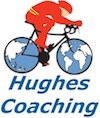 |
|||
 |
|||
 |
|||
 |
|||
 |
|||
 |
|||
 |
|||
 |
|||
 |
|||

|

|
 Follow John Hughes
|
 Follow @HughesCoaching |
|
Intelligent Cycling Training Cycling Resources Updated 4/11/2020 |
|
|
Older Cyclists Anti-Aging Cycling success on a century or other bike ride involves:
General Event Selection—John Hughes, How to select and prioritize centuries, brevets, double centuries and other rides. Stop Cycling’s Showstoppers—John Hughes, Cycling showstoppers can largely be eliminated on a century or brevet by learning how to prepare for bike rides and how to deal with cycling problems on the road. Safety—John Hughes, Almost all accidents are preventable—Here’s how. Centuries and BeyondBenefits from Base Training—John Hughes, Why and how to train at an easy endurance pace. Preparing for a Century The Six Success Factors—John Hughes, PDF of the talk on preparing for and riding a century or 200K at the Denver REI on June 19, 2012. First Century, Preparing For—John Hughes, 8 tips to get ready for your first endurance century. Beyond the Century, How to Train—John Hughes, Training for and riding brevets from 200 km to 1200 km and longer. Brevet(s) & Double Century(s), John Hughes, a two-part article:
Training for Brevets, John Hughes, a two-part article
First Ultra—John Hughes, A three-part article on how to train for cycling more than 100 miles.
Mastering and Finishing Endurance Bicycle Rides—John Hughes, Final preparations for a bicycle ride of 100 km or longer and how to manage the ride to a successful finish. RecoveryOptimal Recovery for Improved Performance—John Hughes, How to recover fully to ride your best. Massage for Cycling—John Hughes, How to do self-massage for recovery from cycling. Icing—John Hughes, When icing is appropriate and how to do it. Stretching—John Hughes, Illustrations of seven key stretches, especially those for muscles prone to cramping, plus other beneficial stretches. Cramping, how to prevent and treat—John Hughes, What to do before and during a ride to prevent cramps and how to break and flush one if it strikes you. Recovery: A two-part article:
Intensity Benefits of Training by Intensity—John Hughes, How training by intensity can make you a better cyclist and save you time. How to Train by Intensity—John Hughes, Guidelines for intensity workouts to get the optimal results. Training Zones—John Hughes, Optimal training by perceived exertion, heart rate and power. Download spreadsheet to calculate your zones. Strength TrainingStrength Training for Century, Brevet and Endurance Cyclists—John Hughes, A two-part article with exercises to develop leg strength, improve muscle balance, strengthen connective tissues, improve upper body endurance and develop core strength.
Strength Training Log—Download a spreadsheet to log your strength workouts. Core Strength Training—John Hughes, Illustrations of core strength exercises. A strong core provides a stable platform to anchor the leg muscles, increasing power, and supports the upper body, reducing upper body fatigue.
General Spring Training—John Hughes, How to structure your training to build endurance and cruising speed for a summer of cycling. Cycling in the Hot Weather—Tips on how to ride both when the weather is hot and when you’re hot from riding hard in mild conditions. Effective Cycling Training, RMCC 2012 Varying the Intensity—John Hughes, PDF of the talk delivered at Rocky Mountain Cycling Club seminar on training for and riding a century or 200K at the Denver Flagship REI March 7, 2012. Peaking for Endurance Cycling Events—John Hughes, Effective training is the least amount of riding necessary to result in continuing improvement. Effective Training Rides, Warren McNaughton & John Hughes, a two-part article:
13 Nutrition Tips for a Century and Brevet—John Hughes, What to eat before, during and after for your best century or brevet. 12 Hydration Myths—John Hughes, Facts about hydration, dehydration and electrolytes. Ultra Nutrition, For a Ride Over 100 Miles—John Hughes, Day to day nutrition to support good training and on the bike nutrition for good performance. Winter Nutrition, —John Hughes, Meeting energy and hydration needs in cold weather. Eating & Drinking Like the Pros—John Hughes, How to Make Your Own Sports Food & Drink—Nutritional insight from pro cycling teams. Nutrition Mantras for Endurance—John Hughes, No matter how hard you train if you don’t fuel properly, finishing a long ride will be difficult. Follow these mantras for nutrition for endurance cycling. Eating for 100 km and Beyond—John Hughes, What to eat before, during and after a cycling event. Eating for Events—Susan Barr, Ph.D., RDN & John Hughes, How to estimate your energy requirements and eat on every 24-hours for cycling events. Experiment of One—John Hughes with commentary by Susan Barr, Ph.D., RDN, Personal example of solving nutrition problems while cycling. Calorie Estimator—Download spreadsheet to calculate total calories burned while cycling based on distance, average speed, total climbing and rider weight.
Clothing for Winter—John Hughes, how to stay warm while cycling in the cold. Bike Fit—John Hughes, How Andy Pruitt at the Boulder Center for Sports Medicine assesses cyclists and sets up their bicycles. Choosing a Long Distance Bicycle—Lon HaldemanTesting Equipment for Long Rides—Warren McNaughton & John Hughes, How to test and perfect cycling equipment and clothing before the season. Points of Contact—John Hughes, Advice on avoiding discomfort on the butt, hands and feet while cycling. Sports Psychology Training for Cyclists—John Hughes, Even though we may plateau physically through learning mental techniques we can continue to improve our performance. Not Fun?—John Hughes, What do to when a bicycle ride stops being fun. Mental Training Techniques, John Hughes, A five-part article:
|
|